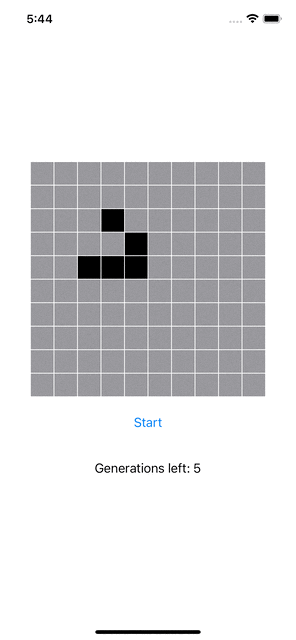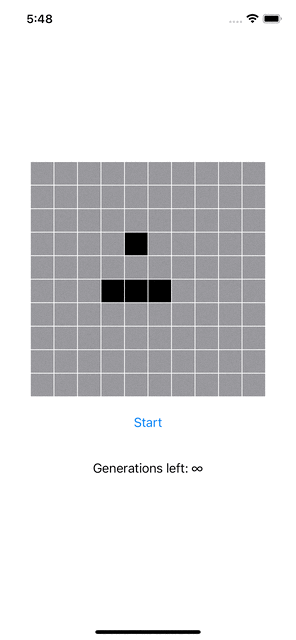GameOfLife
The Game of Life is a cellular automaton. It is a zero-player game, meaning that its evolution is determined by its initial state, requiring no further input. One interacts with the Game of Life by creating an initial configuration and observing how it evolves.
You can easily run these 2 examples above ☝️ by doing (in the GameOfLifeApp):
Game(configuration: .default, generations: .finite(5))or
Game(configuration: .infinite, generations: .infinite)Architecture
I tried to follow closely the SOLID / DRY / KISS / YouNameIt principles.
The business logic is in a separate module to keep code well separated from the UI logic. Thus, we can easily test the business logic without caring about the UI and we can also easily change the UI (text/UIKit/SwiftUI).
Each unit of code has a single responsibility:
- Modules are either responsible for business logic or UI logic but never both
- Each struct takes care of a single responsibility (with less dependency as possible)
- Each function is about doing one simple thing (again, with less dependency as possible)
This allows to easily test the code (which in this case, is heavily tested).
Flow
The flow is quite simple, it starts with a Game that holds a Grid composed of Cells that can either
be .dead or .live.
Apart from that, a Game can be run for a certain amount of Generations.
A Grid have a Size and any of the Cell in the Grid can be access via its Point (let cell = grid[point]).
A Game is initiated with a Configuration that holds the grid size and the initial livePoints (aka seed).
Adaptability
The exercise states that the grid should be of size 10x10 and the game should run 5 generations.
To make sure the code can easily adapt to potential changes, it allows a Game to be initiated with:
- A
Configurationwhich holds aSizethat can be:- Any other size
- A square or even a rectangle
- A
Generationswhich can be:- A
finiteamount of generations for the game to run - An
infiniteloop so the game can run forever
- A
A Configuration can be created with any type of seed.
We could also quickly and easily create a history containing all the generations inside the Game.
Side note 1
The UI was not important but I decided to use SwiftUI as a personal challenge because:
- I’m currently learning about it
- It allows to have some decent UI very quickly and easily
Side note 2
I wanted to use SwiftLint, but unfortunately it's not yet possible within packages (but will soon be!)

